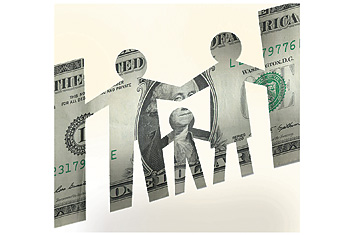
Social issues, particularly the economics of marriage and childbirth, have been major themes in the Republican primary races. As Charles Murray's much-talked-about book Coming Apart points out, marriage is becoming a luxury good: Well-educated rich people get married and stay married. Most of the rest of the population doesn't. This, along with a spate of studies about the growing number of low-income, single-parent families, has spurred a debate about whether government should push marriage as a poverty-elimination tool. But is it really that simple? To quote Beyonc, would poverty go away if we "put a ring on it"?
Statistically it's true that people who have finished high school and are married are less likely to be poor, particularly when you throw children into the mix. But just as government efforts to create an "ownership society" via mass access to mortgages didn't end well, policies that push marriage aren't necessarily the way to bolster prosperity. The causalities of wedlock and the ways in which we capture its economic benefits are, as it turns out, as complex as marriage itself.
The institution has been losing ground for decades. A recent Pew study found that the national marriage rate has hit an all-time low. Meanwhile, the percentage of children born out of wedlock has been rising: it's now 41% overall and 53% for those born to women under 30.
That's the statistic we should really care about, according to experts like Isabel Sawhill at the Brookings Institution. "I don't think people would worry about the decline of marriage if it wasn't for the effect on kids," she says. "All the research shows that there's tremendous turmoil in the lives of children born out of wedlock." Not only are their parents poorer, but they also have a tendency to move in and out of relationships faster. According to Princeton professor Sara McLanahan, it's not unusual for a single or cohabiting parent to have three partners over the course of five years and multiple children with different partners. Forget about moral judgment; the issue is that this rotating cast of characters can create complexity and volatility in the lives of these families.
Cohabitation isn't always associated with such turmoil. In many parts of Europe, couples live together without marrying at much greater rates across the socioeconomic spectrum, and many of those nonmarital unions are more stable than our married ones. (In France the average length of cohabitation is 9.5 years; in the U.S. it's 1.17.) They also tend to lead to marriage more frequently: In Sweden, 82% of cohabiting couples end up sealing the deal. In the U.S., fewer than half do.
But in the U.S., the issue of instability and cohabitation is crucial, because an increasing amount of data shows that poverty is as closely correlated with emotional and financial volatility as it is with absolute income. In short, people who are constantly living on the edge are more likely to fall over it.
Despite all that, researchers who study that correlation, like McLanahan, say pushing people who aren't ready into marriage isn't the solution. "Bush-era programs encouraging people to marry have really had no effect," McLanahan says. Indeed, previously cohabiting American couples who marry have higher-than-average divorce rates. Bottom line: you can't reverse-engineer marriage.
